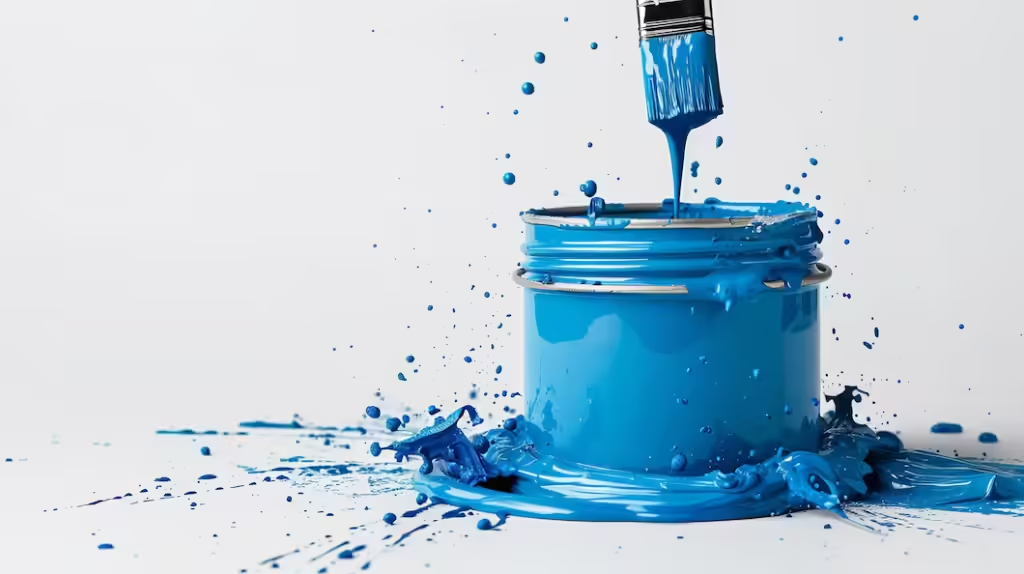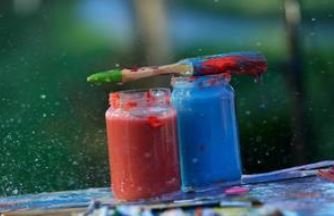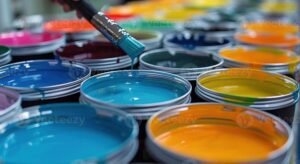Introduction to Water-Based Paint
Water-based paint, also known as latex paint, is a formulation where water acts as the primary solvent. This type of paint has gained widespread popularity due to its various advantageous properties when compared with traditional oil-based paints. Central to its composition are water, binders (often acrylic resins), and pigments, which collectively contribute to its versatility and safety.
The environmental benefits of water-based paints are a major factor in their rising popularity. Unlike oil-based paints that rely on mineral spirits or other volatile organic compounds (VOCs) as solvents, water-based paints significantly reduce the emission of harmful fumes. VOCs are known to contribute to air pollution and pose health risks during and after application. In contrast, the low levels of VOC emissions from water-based paints make them an eco-friendly and healthier option for both indoor and outdoor projects.
The safety profile of water-based paints extends beyond just reduced VOC emissions. These paints are generally easier to clean up using soap and water, eliminating the need for toxic solvents. This makes them particularly attractive for those concerned with both household safety and ecological impact. Consumption trends indicate a growing preference for water-based paints, especially among eco-conscious consumers and professionals aiming to adhere to stricter environmental regulations.
Moreover, water-based paints offer practical benefits such as faster drying times, minimal odors, and greater flexibility, making them less likely to crack or peel over time. These qualities are highly advantageous for both amateur DIY enthusiasts and professional painters seeking efficient and durable solutions.
In summary, water-based paint represents a significant advancement in the realm of painting, merging environmental considerations with ease of use. Its fundamental properties, including reduced VOC content and straightforward cleanup, combined with a growing preference for more sustainable and safer options, underscore its increasing appeal in both residential and commercial settings.

Advantages of Using Water-Based Paint
Water-based paint has garnered widespread acclaim due to its numerous benefits that cater to a diverse range of applications, from interior walls to exterior finishes. Among the most notable advantages is its low volatile organic compound (VOC) content. VOCs are chemicals that evaporate from the paint and contribute to air pollution and smog formation. By opting for water-based paint, users significantly reduce the emission of these harmful compounds, fostering a healthier indoor environment and complying with stringent environmental regulations.
Quick drying time is another crucial benefit of water-based paint. Unlike traditional oil-based paints, which can take several hours or even days to dry completely, water-based paints dry within a couple of hours. This accelerated drying time allows for faster project completion, minimizing downtime and inconvenience. For indoor projects, this means rooms can be reoccupied sooner, and in commercial settings, business operations can resume more rapidly.
Ease of cleanup is often a decisive factor for both professionals and DIY enthusiasts when selecting paint. Water-based paint can be effortlessly cleaned from brushes, rollers, and other tools with just soap and water. This stands in stark contrast to oil-based paints, which require solvents like mineral spirits for cleanup, adding to both the cost and the environmental impact. The simplicity of water-based paint cleanup not only saves time but also reduces the overall project cost.
Reduced odor is another prominent advantage of water-based paint. Traditional paints, laden with various solvents, can leave behind a lingering, unpleasant odor that can last for days. Water-based paints, on the other hand, emit minimal odor, making them more comfortable to work with, especially in enclosed spaces. This property extends their suitability to sensitive environments such as hospitals, schools, and homes with children or pets.
These combined benefits of water-based paint—low VOC content, quick drying time, ease of cleanup, and reduced odor—make it an exceptionally preferable choice for both indoor and outdoor applications. Whether tackling a home renovation or a large-scale commercial project, water-based paint offers an efficient, eco-friendly, and user-friendly solution.
Types of Water-Based Paints
Water-based paints are celebrated for their ease of use, environmental benefits, and versatility. Among the popular types are acrylic latex, vinyl acrylic, and water-based enamel. Each of these has distinct characteristics making them suitable for different use scenarios.
Acrylic Latex: Acrylic latex paint is perhaps the most widely known and used type of water-based paint. Made from acrylic resins, it is known for its durability and flexibility. This type of paint adheres well to a variety of surfaces, including wood, metal, and masonry, making it a dependable choice for both interior and exterior applications. Additionally, acrylic latex offers excellent color retention and resistance to fading, cracking, and peeling, which contributes to its popularity for residential applications.
Vinyl Acrylic: Vinyl acrylic paint is another variation that leans heavily on its cost-effectiveness. It incorporates vinyl acetate polymers, which make it a suitable choice for interior walls and ceilings. Due to its lower resistance to environmental stressors, it is less ideal for exterior surfaces but excels in spaces that do not require heavy-duty durability. Its affordability and ease of application make it a common choice for DIY projects and new constructions.
Water-Based Enamel: Water-based enamel paint stands out for its glossy finish and hardness, which are traditionally associated with oil-based enamels. However, water-based enamel offers the added benefits of faster drying times and lower VOC emissions. This type of paint is ideal for areas that demand a hard, durable finish, such as cabinetry, trim, and doors. It provides a resilient surface that withstands frequent cleaning and wear, making it perfect for high-traffic areas.
Understanding the distinct characteristics of these water-based paint varieties helps in selecting the right type for specific applications. While acrylic latex offers versatility, vinyl acrylic provides an economical option, and water-based enamel delivers a durable and attractive finish. Each type uniquely enhances the appeal and functionality of different surfaces, thereby catering to varying project requirements.

Choosing the Right Water-Based Paint for Your Project
When selecting the appropriate water-based paint for your project, several factors come into play, each influencing the final outcome significantly. The surface to be painted, the desired finish, and any specific project requirements should all be considered to ensure optimal results.
First and foremost, identify the surface you intend to paint. Water-based paints, such as acrylic or latex, are versatile and can be used on a variety of surfaces, including wood, drywall, and masonry. However, choosing the right type of water-based paint for the specific surface can enhance adherence and longevity. For instance, for exterior surfaces exposed to weather elements, opting for specially formulated exterior water-based paints can provide better durability and protection.
The desired finish is another crucial element. Water-based paints are available in a range of finishes, including matte, gloss, and satin. Each finish offers distinct advantages and aesthetic appeal. A matte finish provides a non-reflective surface, ideal for concealing wall imperfections. Gloss paints, on the other hand, offer a shiny, durable coat, suitable for high-traffic areas or surfaces requiring frequent cleaning, such as kitchen and bathroom walls. The satin finish strikes a balance between matte and gloss, providing a velvety sheen that is both attractive and somewhat forgiving of surface imperfections.
Understanding the specific requirements of your project is essential. Specialized water-based paints are available for unique conditions – such as mildew-resistant paints for bathrooms or paints with added binding agents for better adhesion to difficult surfaces. Reading labels meticulously helps ascertain these properties, ensuring the selected paint meets your project’s specific needs. Look for information regarding paint coverage, dry time, and environmental considerations like low Volatile Organic Compounds (VOCs) for eco-friendly applications.

Preparing Surfaces for Water-Based Paint
Proper surface preparation is crucial to achieving a smooth and durable finish when using water-based paint. The first step in this process involves thoroughly cleaning the surface. Dust, dirt, grease, and other contaminants can negatively impact paint adhesion, so it is important to ensure the surface is free from any debris. A mixture of mild detergent and water is generally effective for cleaning most surfaces. For tougher grime, a degreaser may be necessary. Rinse the surface well and allow it to dry completely before proceeding.
Next, it’s important to address any surface imperfections. This includes filling any holes, cracks, or dents with a suitable filler. Once the filler is applied, it should be sanded down to be flush with the surrounding surface. Sanding is a critical step that helps to create a smooth texture for the paint to adhere to. Use fine-grit sandpaper and sand in a circular motion to achieve the best results. After sanding, remove any dust and particles with a vacuum or tack cloth to ensure a clean surface.
Priming is the next essential step in preparing a surface for water-based paint. Primers help to seal the surface, enhance paint adhesion, and ensure even color distribution. When selecting a primer, opt for one that is compatible with water-based paints. Apply the primer evenly, using either a brush or roller, and allow it to dry as per the manufacturer’s instructions. Depending on the nature of the surface, a second coat of primer may be necessary to achieve full coverage.
Finally, evaluate the prepped surface to ensure that it is smooth and free of any remaining imperfections. Address any areas that may need additional sanding or filling. Once the surface is properly cleaned, sanded, and primed, it is ready for the application of water-based paint. Proper surface preparation is the foundation of a successful painting project, setting the stage for a professional and long-lasting finish.

Application Techniques for Water-Based Paint
When applying water-based paint, achieving a flawless finish involves mastering certain techniques and employing the right tools. Brushes, rollers, and sprayers are the primary tools used to apply water-based paints, each best suited for specific scenarios. For a smooth, professional result, understanding the nuances of these application methods is crucial.
Firstly, selecting the appropriate brush is pivotal. High-quality synthetic brushes are recommended for water-based paint, as natural bristles can absorb water and become limp. When using a brush, load it with an adequate amount of paint, removing excess by tapping it against the side of the container. Apply the paint using long, even strokes, maintaining a wet edge to prevent lap marks. Lightly feather the edges to blend fresh paint seamlessly with partially dried sections.
For larger, flat surfaces, rollers are often the tool of choice. A roller with a synthetic nap, typically 1/4 to 1/2 inch in length, works well for water-based paint. Begin by evenly loading the roller cover with paint, rolling it back and forth in a paint tray to coat it thoroughly. Apply the paint in a ‘W’ or ‘M’ pattern, then fill in by rolling over the blank areas. This method helps distribute the paint evenly and minimizes the risk of streaks or lap marks. Always roll in various directions to ensure complete, uniform coverage.
Sprayers, such as airless sprayers, can provide an ultra-smooth finish devoid of brush marks or roller textures. When using a sprayer, thin the water-based paint as per the manufacturer’s instructions, if required. Test the sprayer on a piece of cardboard or similar surface to get accustomed to its spray pattern. Maintain a consistent distance from the surface, usually 10-12 inches, and use steady, overlapping strokes to build up an even layer of paint.
To ensure a professional-looking result, it is essential to avoid common mistakes such as overloading the brush or roller, which can result in drips and uneven coverage. Work in manageable sections and maintain a wet edge to blend new paint with existing sections seamlessly. Lastly, allow appropriate drying time between coats, as rushing through the application process can compromise the finish.
Maintenance and Durability of Water-Based Paint
Water-based paints are renowned for their environmentally friendly properties and ease of application, but maintaining their appearance and durability requires regular care. Establishing a consistent cleaning routine is essential for preserving both the look and longevity of painted surfaces. Typically, a gentle dusting with a microfiber cloth can help remove surface dirt and prevent buildup. For more stubborn stains, using a mild, non-abrasive cleaner diluted in water and a soft sponge is recommended. Abrasive cleaners or scrubbers should be avoided, as these can damage the paint finish and compromise its durability.
Touch-ups are an inevitable part of maintaining any painted surface. Minor chips or scratches can be easily addressed using leftover paint from the original application. Be sure to store any leftover paint in a tightly sealed container to ensure it remains viable for future use. Lightly sand the affected area and clean it thoroughly before repainting to ensure a smooth, cohesive finish. For larger or more pronounced areas of wear, it may be necessary to repaint the entire section to achieve uniformity in color and texture.
In case of more severe damage or significant wear, such as peeling or bubbling, it is crucial to address the underlying cause before any repair work. Moisture intrusion or inadequate surface preparation can lead to such issues. Identifying and rectifying these problems will prevent recurrent damage. Once the underlying issue is resolved, the damaged paint should be carefully removed, the surface properly prepared, and then repainted following the manufacturer’s instructions.
Regular inspections of painted surfaces can also help catch any issues early, allowing for timely maintenance and extending the lifespan of the paint. By incorporating these practices into your routine, you can ensure that water-based paint surfaces remain vibrant and durable, maintaining their aesthetic appeal and protecting the underlying material for years to come.

Environmental and Health Benefits of Water-Based Paint
Water-based paint is increasingly recognized for its significant ecological and health advantages. One of the most notable benefits is its low toxicity. Unlike oil-based paints that contain volatile organic compounds (VOCs), water-based paints have a minimal amount of these harmful chemicals. Consequently, using water-based paint helps to improve indoor air quality, making it a healthier option for residential and commercial spaces.
The reduced presence of VOCs in water-based paint is crucial for promoting a safer living environment. Exposure to high levels of VOCs can cause various health issues, including respiratory problems, headaches, and eye irritation. Furthermore, long-term exposure may lead to more severe health complications. By choosing water-based paint, families and pets are less likely to experience these adverse health effects, contributing to a safer and more comfortable living space.
Moreover, water-based paint has less environmental impact compared to its oil-based counterparts. The production and disposal of oil-based paints contribute significantly to environmental pollution. VOCs released into the atmosphere contribute to the formation of ground-level ozone and smog, which are harmful to both human health and the environment. In contrast, water-based paints emit fewer VOCs, reducing air pollution and the potential for environmental degradation.
The cleanup process for water-based paint is also more environmentally friendly. Cleaning brushes and rollers used with oil-based paints requires the use of harsh solvents, which are themselves pollutants and can harm aquatic life when disposed of improperly. Water-based paints, however, can be cleaned with simple soap and water, reducing the environmental footprint of the painting process.
In summary, water-based paint offers considerable ecological and health benefits. Its low toxicity improves indoor air quality, promotes a healthier living environment, and reduces environmental impact. As awareness of these advantages grows, water-based paint is set to become the preferred choice for those looking to create safer, greener spaces.
